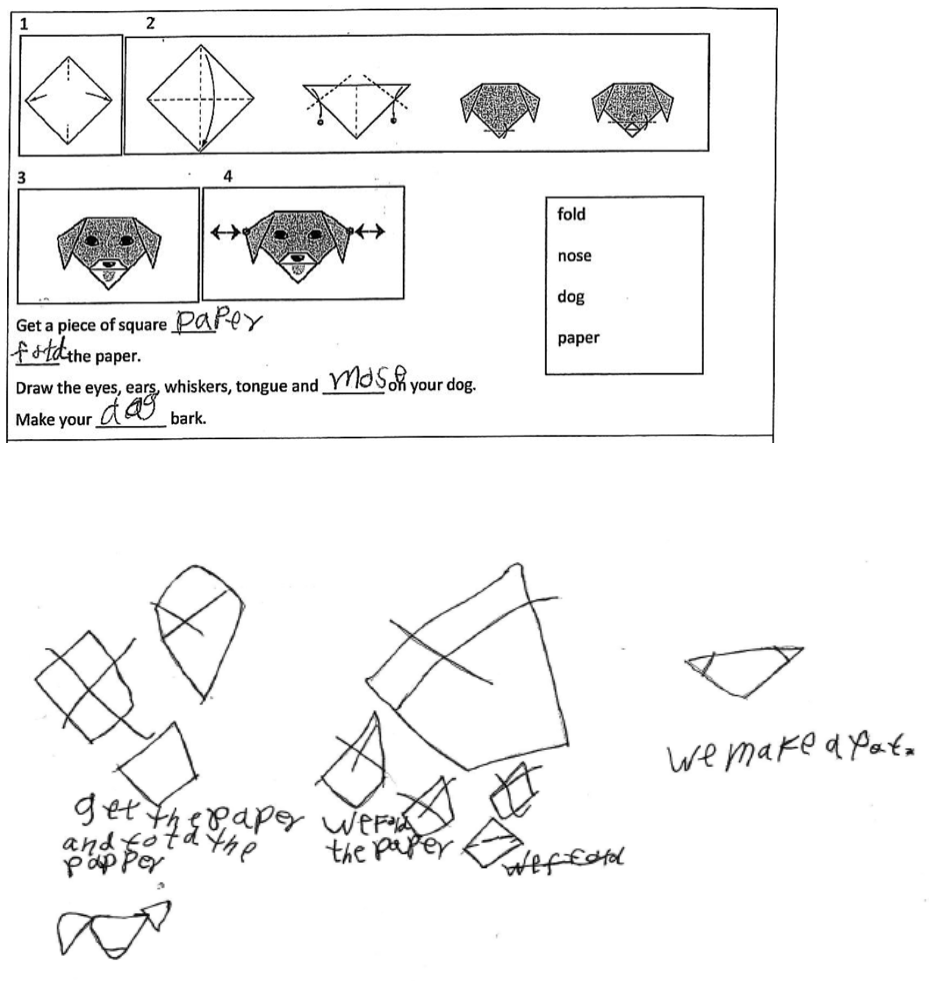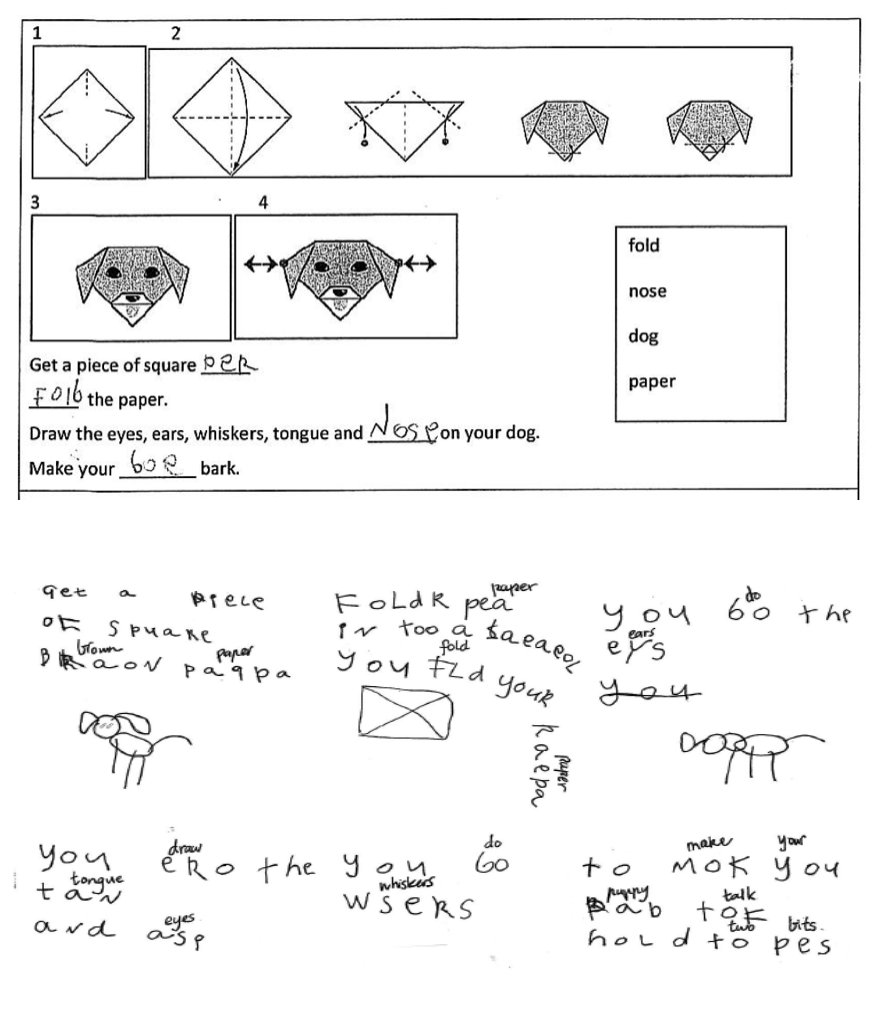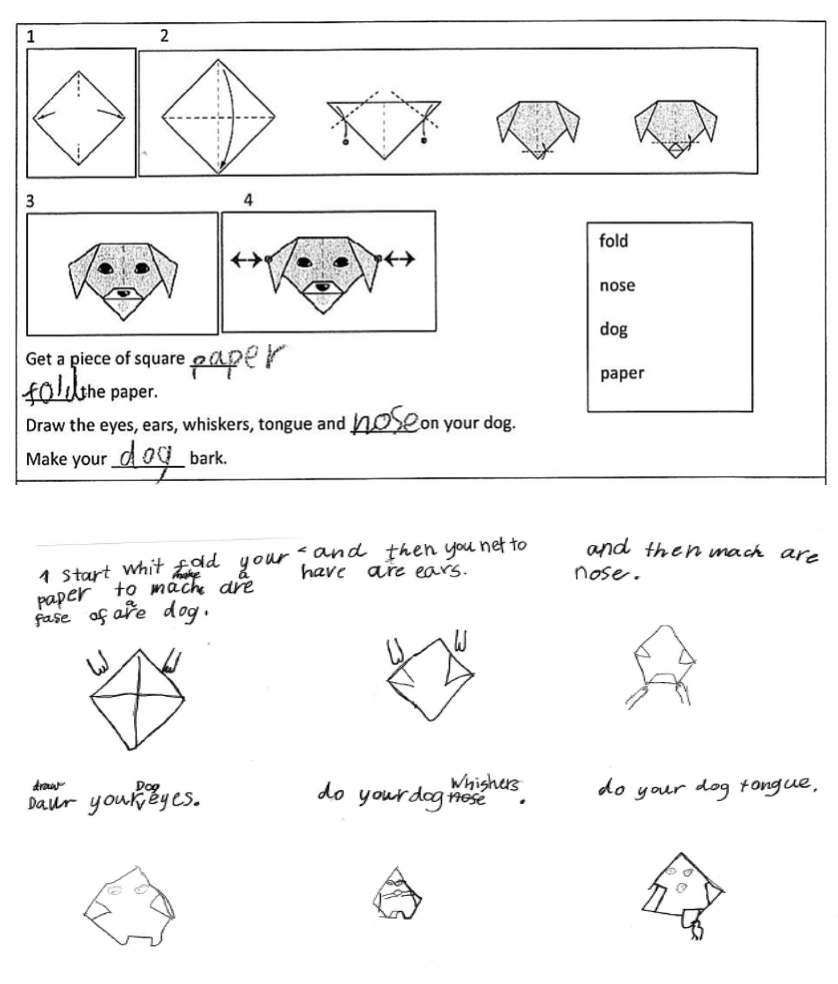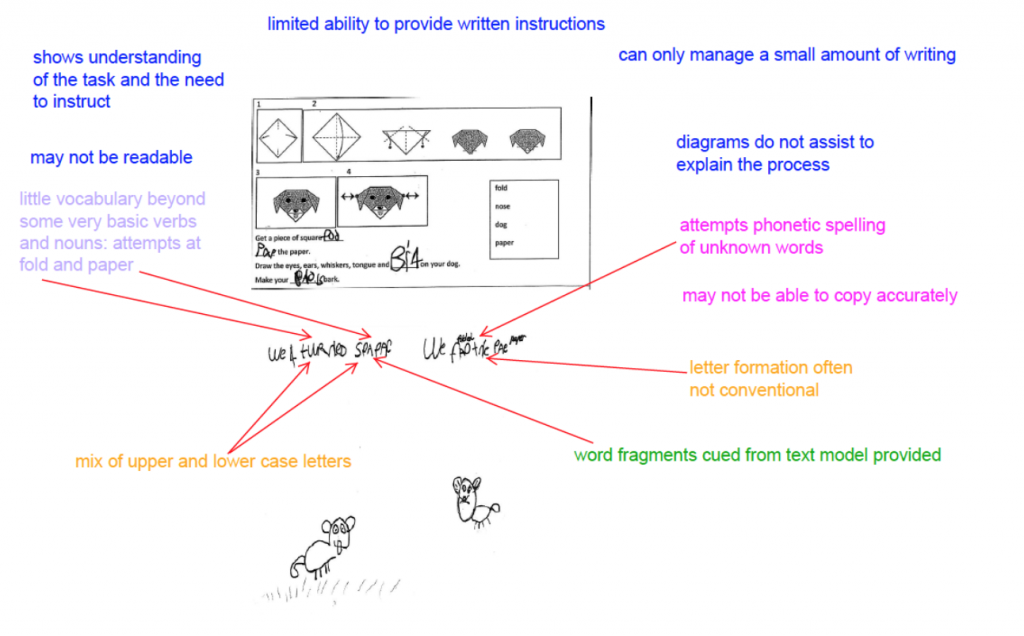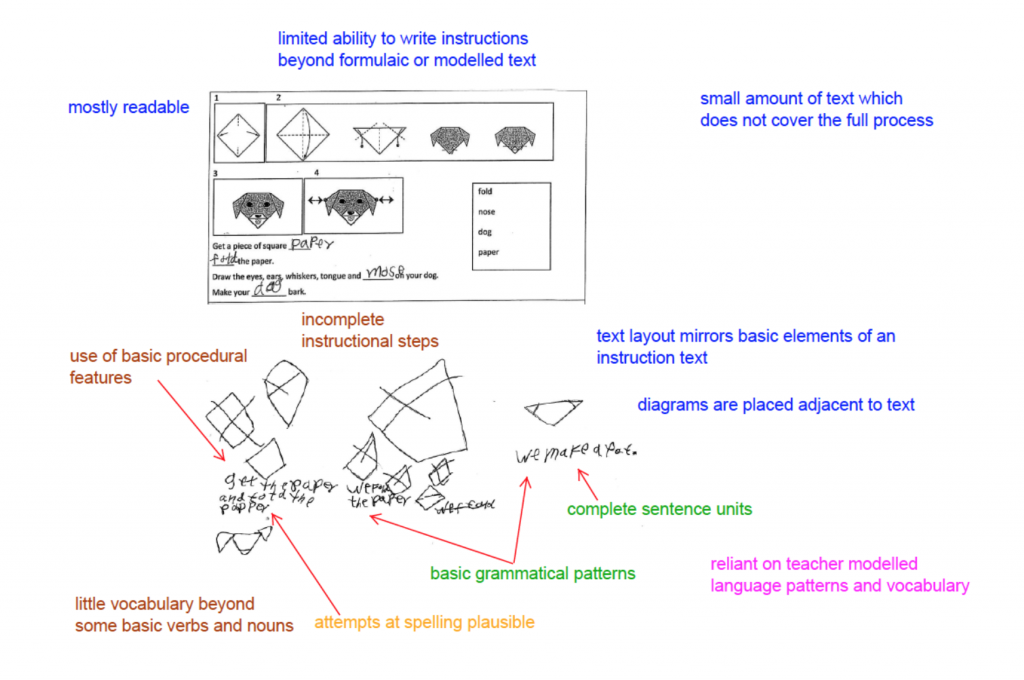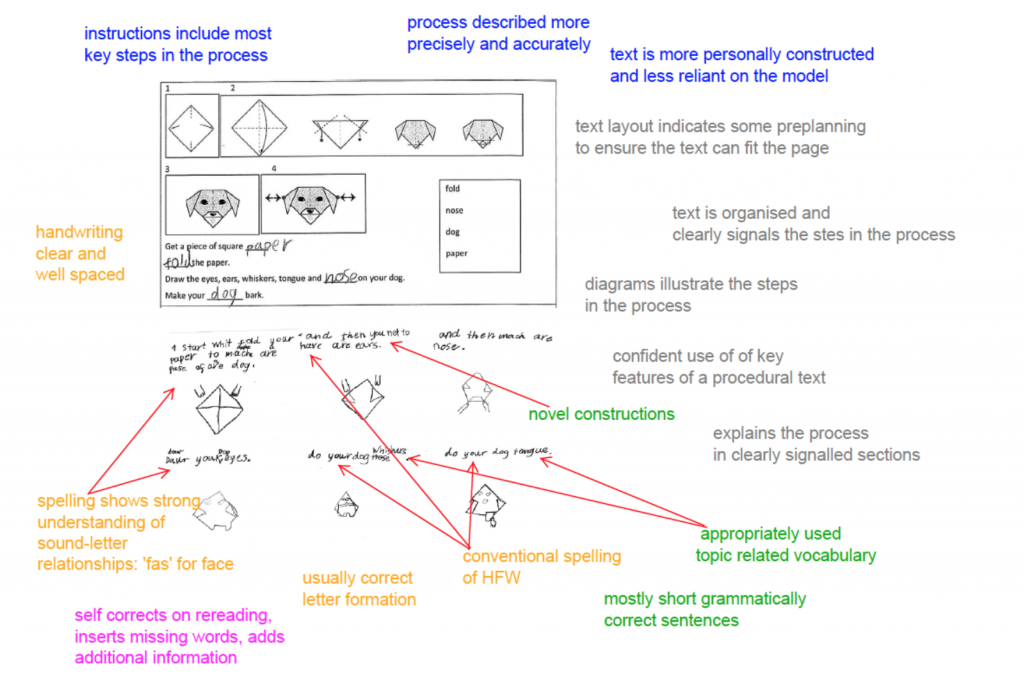4. How to make an origami dog
Please click on the toggles below to navigate through information on this assessment task and reveal the links for downloading task materials.
Task details |
|
| Name of writing assessment task | How to make an origami dog |
| EAL student stage range | A1, A2, BL, B1, B2, CL, C1 |
| Text orientation | Informative |
| Task type | Procedure |
Task specification |
|
| Purpose | To assess students’ ability to write simple instructions. |
| Description | After making a simple origami dog, following instructions from the teacher, students match four sentences to diagrams, fill the gaps in the sentences with the missing words. They then write their own instructions on how to make the dog. |
| Assumed knowledge and description |
|
Learning/teaching context |
|
| Language centre/mainstream class | Small group |
| Subject/key curriculum objectives, outcomes | English, Maths |
| Topic/teaching unit | Animals |
| Assessment conditions |
|
| Notes | |
Task implementation |
|
| STAGE | ACTION STEPS |
| Pre-assessment activity |
|
| Assessment activity |
|
| Post-assessment activity |
|
Click here for unmarked assessment criteria:
- TEAL Writing Task 4- unmarked criteria sheet [PDF]
- TEAL Writing Task 4- unmarked criteria sheet [Word]
An explanation of the purpose, nature and use of criteria sheets is available at 4. Using the assessment criteria.
Commentary
Purpose and value of task
This task assesses students’ abilities to write the instructions on how to make a simple origami dog. This task relates to Oral Task 4: How to make an 0rigami dog, in which students are asked to instruct the teacher on how to make the dog. Other related TEAL tasks involving procedural texts are TEAL Writing Task 13: Making a pizza: text reconstruction (recipe) and TEAL Oral Task 7: Playing a card game (spoken instructions).
The task assesses students' abilities to write instructions rather than to recount what they did. They need to logically present the process, and to use task specific nouns and verbs as well as basic procedural language. The task is quite demanding on their English language resources, as they need to sequence and explain the process. Students can draw diagrams to add to their instructions.
As students oral English language proficiency increases, they are both more able to understand the language demands of a conventional text type, and to use the structures and features associated with it. Hand in hand with this growing English language proficiency is growth in their ability to actually put their words on the page, encompassing skills in handwriting and in English sound-letter understanding. These two aspects of the ability to write in English do not always develop together, and are age dependent, and dependent on the students’ prior experiences with literacy learning in their first language. Some students will not yet be able to write what they want to because of their limited writing skills, while other may understand more of the writing process but do not yet have enough English to write what they want to write. Students at these very early stages (particularly A1, BL and CL) may simply find the physical task of writing very demanding, and may not yet be capable of writing much text. A careful analysis of students writing using the criteria sheets across a range of tasks will assist in assessing all aspects of their writing skills and of their developing knowledge of English.
By watching students as they write, teachers will gain important insights into the strategies that they are using: Do they already know how to write some high frequency words, and do so without difficulty? Do they copy words from personal dictionaries or classroom word charts? Do they attempt to spell words themselves? Are they able to reread and self-correct?
Older students can be given a more complicated origami task as the basis for the assessment. The teacher interaction as students write should be confined to answering clarifying questions, and to showing the students how to write words if they ask.
Contextual information
The students who provided the samples were in Years 1 and 2, and were receiving specialist EAL support. They came from a range of language backgrounds. The students were all prepared for this assessment task by making their origami dog following the instructions on the assessment task. This gave them an opportunity to become familiar with the necessary vocabulary, and to see how it was written. It also gave them some familiarity with the features of an instructional text. They then talked about what they had done, and completed the task sheet, with teacher assistance. They then wrote their own instructions. Some students were more reliant on the task sheet when they wrote their texts, needing to copy rather than being able to write their own texts. The students read back their writing to the teacher who has written correct word and phrases above what the student has written.
Commentary
It is clear from the samples that the students are still at very early stages of working out how to write in English. They all understand the need to write instructions, but their ability to do this is variable. However, their texts, although short, can be very revealing of their stage of development in learning to write. Students’ ability to draw their diagrams is also variable.
The students employ a range of strategies to write their texts, including attempts at spelling using their developing understanding of the sound symbol relationships of English. Some students seem to prefer to attempt spelling words their own way, while others seek out other strategies such as memorising or copying words.
Commentary
Although this sample is very short, it shows that the student has some key basic understanding of how to write in English. He or she has written in a left to right direction, starting at the top of the page.
The attempts at spelling show some initial understanding of sound-letter relationships in English. The text appears to be a recount rather than a procedure, as the sentences start with 'we'. The diagrams relate to the text. It is likely that, at their stage of development, the student would not be able to independently write much more text than this for an activity such as this one, but he or she has moved beyond simply labelling or relying completely on drawing pictures, which is a common strategy for students right at the very beginning of learning English and learning to write in English. The student was able to read back the sentences that were written.
The worksheet extract shows that the student is not yet able to complete this task, although he or she understands the need to write something in each blank space. The student may not have fully understood the task, or may not been able to read the prompt sentences without assistance.
The student’s handwriting is developing. Although there is a mixture of upper and lower case letters, and some novel forms, they are of appropriate size. There are spaces between the words, and between the sentences. No punctuation is evident.
The marked criteria sheet shows that the student meets most criteria at level 1 of performance.
The student’s language use in this task is consistent with the descriptions of students at Level A1, Victorian Curriculum F-10 EAL.
TEAL Writing Task 4 – criteria sheet – Sample 1
Using this assessment for further learning
(Select the points you think are currently of most importance to the student.)
- After asking the student to reread the text, ask for further information, and scribe this, expanding on what the student has said, and using the structures and features of a simple procedural text, for example, First fold the paper. Then draw the eyes and ears and whiskers. Make the dog bark.
- Point out to the student where you have used upper and lower case letters.
- The student can then be asked to copy the sentences onto a fresh sheet. Add the first draft and copied correct sentences to the student’s portfolio.
- Choose two or three high-frequency words to add to the student’s dictionary or to a wall chart.
Commentary
This student is able to write more, and more accurately, than Sample 1. The text is initially instructional in tone, using the imperatives ‘get’ and ‘fold’ – get the paper and fold the paper, but becomes more of a recount in the second section – we fold the paper. The diagrams relate clearly to the text, and both text and diagrams are appropriately positioned on the page.
The spelling appears to be a mixture of words which the student already knows how to spell, or has copied, and attempts at spelling. The word ‘paper’ is spelt differently in two sections of the text.
The handwriting is not always clear, and some letter formations are problematic, but this student seems to have a clearer understanding than the student in Sample 1 of when to use upper and lower case letters. Full stops are used at the end of two of the sections.
The marked criteria sheet shows that the student meets most criteria at level 1 of performance.
The student’s language use in this task is consistent with the descriptions of students at Level A1, Victorian Curriculum F-10 EAL.
TEAL Writing Task 4 – criteria sheet – Sample 2
Using this assessment for further learning
(Select the points you think are currently of most importance to the student.)
- After asking the student to reread the text, ask for further information, and scribe this, expanding on what the student has said, and
using the structures and features of a simple procedural text, for example: First fold the paper. Then draw the eyes and ears and whiskers. Make your dog bark.
- Point out to the student where you have used upper and lower case letters.
- The student can then be asked to copy the sentences onto a fresh sheet. Add the first draft and copied correct sentences to the student’s portfolio.
- Choose two or three high frequency words to add to the student’s dictionary or to a wall chart.
Commentary
This student is able to attempt more text than the other two samples and to give more detail in the instructions – you draw the tongue you draw the eyes. Although the student has written the instructions in blocks of text across and then down the page, the positioning of the text within these blocks is less successful, and it is not always clear which block of text words belong to.
Although the text is difficult to read, the sentence structure is reasonably advanced – to make your puppy talk hold … indicating a higher stage of English language development than the previous samples.
The student has attempted the spelling of many words, and shows a strong understanding of basic sound letter relationships in English (wseks = whiskers, tok = talk) although at times his or her handwriting is not clear, which makes it difficult to be sure which letters have been written. The student seems to be particularly confused with b, d and p, which is not unusual at these early stages. Some letter formations are problematic, and upper and lower case letters are not always used appropriately.
The marked criteria sheet shows that the student meets criteria across most levels of performance.
The student’s language use in this task is consistent with the descriptions of students at Level A2, Victorian Curriculum F-10 EAL.
TEAL Writing Task 4 – criteria sheet – Sample 3
Using this assessment for further learning
(Select the points you think are currently of most importance to the student.)
- After asking the student to reread the text, ask for further information, and scribe this, expanding on what the student has written.
- Point out to the student where you have used upper and lower case letters.
- The student can then be asked to copy the sentences onto a fresh sheet.
- Add the first draft and copied correct sentences to the student’s portfolio.
- An appropriate focus for spelling for this student would be to choose high frequency words such as the verbs ‘make’ and ‘draw’, or body parts ‘eyes’, ‘ears’, ‘nose’ and ‘mouth’. Talk about the sounds and letters which make up these words. Put these on a chart, add other high frequency words with similar patterns to the chart and ask the student to illustrate them. For example, ‘draw, saw, paw’.
Commentary
This student’s work is much more carefully set out on the page than other samples, showing a clear understanding of the needs of the reader and the basic requirements of the text type. It is written in clear sections, appropriately spaced. The sentences mostly follow very simple patterns – make a nose, do your dog tongue, but still provide clear and logical instructions, with most of the key steps included. The student has placed the illustrations below each of the instructions. The illustrations relate strongly to the text.
The student seems to have used his or her ‘own words’ in the instructions, using the time marker ‘start’. Ideas are linked using ‘and’, and the imperative ‘do’ is used.
The spelling seems to be a mixture of known high frequency words, some copied words and attempts at spelling, ‘mach’ for make, ‘are’ for ‘a’, and ‘fase’ for ‘face’.
The handwriting is clear, and placed on an ‘imaginary line’. Lower case letters are used throughout, and the student does not yet seem to understand the need for an upper case letter to start a sentence, although full stops are placed at the end of sentences.
The student had been able to read the text back to the teacher who has made corrections.
The marked criteria sheet shows that the student meets criteria at levels 3 and 4 of performance.
The student’s language use in this task is consistent with the descriptions of students at Level A2, Victorian Curriculum F-10 EAL.
TEAL Writing Task 4 – criteria sheet – Sample 4
Using this assessment for further learning
(Select the points you think are currently of most importance to the student.)
- Point out to the student where upper case letters should be used to start a sentence.
- Talk to the student about why it would be better to use the word ‘draw’ instead of ‘do’ in his/her sentences.
- The student can then be asked to copy the corrected sentences onto a fresh sheet or to make a small book.
- The student could also type the sentences onto a computer.
- The student could also focus on spelling by choosing two or three words to add to his/her personal dictionary or to a class wall chart.
- The student could also be asked to think of other high frequency words with similar patterns to the chosen words, which could be added to the chart.


